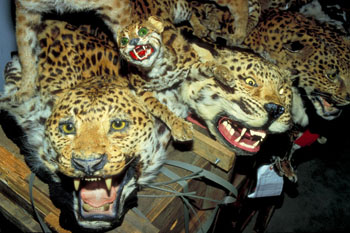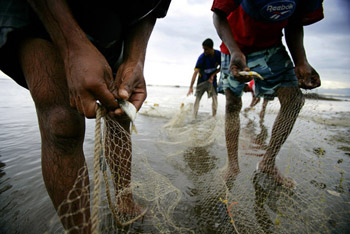Wildlife trade, biodiversity, and wider environmental concerns
The commercial use by people of wild animal and plant resources is an issue at the heart of the relationship between biodiversity conservation and sustainable development.
Wildlife trade, people, and conservation incentives
The historical impacts of wildlife trade on the status and security of biological resources have largely been negative.
Scale and dynamics of the trade today
The trade in wild plants and animals and their parts and derivatives is big business.
Understanding the challenge
Most of wildlife trade is legal, but a significant portion of it is not.
Action for change
There is an urgent need for knowledge and action.



Effective regulation:
Governments (with stakeholder input) enact, adapt, implement and enforce policies and legislation that ensure trade in wild animals and plants is not a threat to the conservation of nature.
Positive economic and social incentives:
Governments and the private sector develop and adopt economic policies and practices that provide incentives and benefits that encourage the maintenance of wildlife trade within sustainable levels and support effective wildlife trade regulation.
Sustainable consumer behaviour:
Traders and consumers make choices in their wildlife purchasing decisions that do not threaten the conservation of nature.
Mobilized knowledge:
Decision-makers at all levels acquire and apply sound knowledge about the scope, dynamics and conservation impact of wildlife trade and its response to different management measures and approaches.

i. Early warning
Catalysing responses to new and emerging knowledge about wildlife hunting, harvest and trade levels, patterns and trends
ii. Flagship species in trade
Catalysing urgent action for emblematic threatened species that act as flagships of wider trade and conservation challenges
iii. Resource security and wildlife trade
Supporting trade measures that help encourage sustainable practice within some major wildlife resource sectors
iv. Wildlife trade routes
Taking focused action along priority trade routes to reduce wildlife trade threats to priority centres of biodiversity, species and resources
v. Rapid response and innovation
Responding to emerging regional wildlife trade issues and promoting innovative approaches and solutions


Research
TRAFFIC's research methods include: market surveys; assessment of trade mechanisms, routes, economics and motivations; analysis of official trade statistics; collation of observations and findings of other researchers; and specific investigations of illegal trade activities.
Analysis
TRAFFIC's analysis of conservation problems and solutions is objective, multi-disciplinary and knowledge-driven and is carried out in conjunction with specialists in a wide variety of disciplines, including species conservation, ecology, economics and law. Recommendations resulting from this work are based on direct experience of developing and assisting with the implementation of practical solutions to wildlife trade problems.
Proposing solutions
TRAFFIC advises the development of policies, practices and actions to address the conservation challenges it has identified, exploring the application of innovative solutions and strategies and learning from analyses of the effectiveness of previous approaches. In proposing solutions, particular attention is paid to striking a balance between regulatory “supply control” approaches and incentive- and consumer-based “demand driven” approaches. Key fora for such interventions include CITES, CBD and other international conservation and resource management agreements as well as regional and national level decision-making processes.
Advocacy and awareness
TRAFFIC targets the communication of its findings and recommendations to audiences and individuals in a position to influence remedial conservation action; its advocacy initiatives are designed to strengthen such communications to decision-makers, particularly at national and regional governmental level and in international treaty meetings, but also in the private sector. Raising public awareness of wildlife trade issues is a secondary, though important, goal of TRAFFIC communications work.
Supporting remedial action
TRAFFIC organizes and assists training and other capacity-building initiatives for officials involved in regulation of wildlife trade. TRAFFIC provides technical advice and often mediates or facilitates multi-sector and inter-governmental consideration of solutions to wildlife trade-related conservation challenges.

As the focal programme within both WWF and IUCN on issues related to trade in wild animals and plants, TRAFFIC represents a partnership that unites the considerable strengths of each of these major global conservation organizations. TRAFFIC uses IUCN's and WWF's scientific information on species and ecosystems, knowledge from the WWF and IUCN field programmes and its own trade-related research to provide analyses and recommend positions on wildlife trade issues to WWF and IUCN and to external audiences through advocacy and communications action. IUCN and WWF use TRAFFIC's analyses and their own knowledge to shape and advocate policies and positions on wildlife trade issues. Through partnership, TRAFFIC helps deliver key components of both WWF and IUCN missions and programmes.